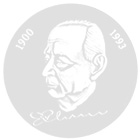For the invention of the deep reactive ion etching process (Bosch Process), a key process for manufacturing semiconductor sensors
Sensors are the sensory organs of our machines and technical systems. They can be found everywhere today, in cars, in mobile phones, and in many parts of our daily lives. Against the backdrop of the megatrends IoT (Internet of Things) and AI (Artificial Intelligence), the importance of sensors will reach a new dimension. Without these small electronic helpers, no intelligence of things is possible. The demand for sensor technology will continue to grow rapidly in the future and manufacturers will be confronted with the challenge of having to serve a very dynamic market: New applications require ever more specific, often complex and at the same time cost-effective sensors, and in high volumes. This year’s two prizewinners, Andrea Urban and Franz Laermer, created a significant basis for this by inventing deep reactive ion etching already in the 1990s.
Today, many sensors are manufactured in high volumes using modern semiconductor manufacturing processes. The semiconductor production of sensors is not new; silicon pressure sensors have been manufactured since the 1970s. In the 90s, acceleration and yaw rate sensors followed. In these types of sensors, signals are recorded mechanically, converted into electrical signals and digitized. The combination of the smallest mechanical and electronic systems is called “micro electro mechanical system” (MEMS). Typical dimensions of the mechanical components are in the range of micrometers, which is one-fiftieth of the diameter of a human hair. The manufacture of precise mechanical components is very important for sensor functions and was for a long time possible only to a limited extent. Until the beginning of the 1990s, the height of the smallest mechanical structures could be precisely controlled by the deposition of thin layers. However, lateral structuring was difficult because the etching processes known so far were mainly non-directional, i.e. they did not work vertically downwards but in all directions.
The breakthrough came when Andrea Urban (née Schlip) and Franz Laermer invented deep reactive ion etching. The idea of the two researchers: They split the structuring into many small partial steps, thus decisively expanding the possibilities of structuring. First, a small etching step is carried out, which acts vertically downwards but also laterally, thus creating a small etching pit. Then a passivation takes place to protect the walls from the next etching. The next etching step breaks through the passivation at the bottom of the etching trough due to the directional reactive etch ions. After that renewed passivation is immediately carried out, followed by etching again. Since the penetration of the passivation always takes place at the bottom of the etching area first, the result is a directional etching perpendicular to the bottom of the semiconductor material. In this way, many small repeated steps create vertical walls. The term “walls” suggests large dimensions, but this is misleading because the typical dimensions are only a few micrometers.
Thanks to the new process, fine mechanical structures, such as those required for pressure, acceleration and yaw rate sensors, can be produced much more precisely and cost-effectively. In the 1990s, this “revolution in the µ-range” set new standards in the automotive industry: ESP and antilock braking mechanisms were no longer reserved for the luxury car class. The automotive industry did not remain the only mass market – today, for example, the so-called “9 DOF (9 degrees of freedom) sensor” in our smartphones ensures greater user comfort by automatically adjusting the screen to our own position, for example. 9 DOF combines acceleration, yaw rate and magnetic sensors in a single highly integrated package. The high-precision microphones of smartphones are also semiconductor MEMS, manufactured using the reactive ion deep etching process. As we move increasingly into virtual worlds in the future, we also owe the amazingly realistic impressions to deep reactive ion etching.
The process, today known as the Bosch process, is a key process for the manufacture of semiconductor MEMS. Bosch is the world market leader in semiconductor sensors and microsystems: Since 1995, the company has manufactured over 10 billion MEMS devices and is currently building a new semiconductor factory for microsystems in Dresden.
The Bosch process has revolutionized industrial sensor manufacturing. This makes the thoughtful and modest behavior of the two faces behind the innovation all the more impressive. Andrea Urban and Franz Laermer would probably not use the word “revolution”. They recognized a problem and then developed a solution for it with systematic and persistent work – a solution, of course, that already at that time laid a decisive basis for the technological visions of tomorrow. Deep reactive ion etching is definitely one of the door openers for the Internet of Things – IoT.
Prof. Dr. rer. nat. Christoph Kutter, Fraunhofer EMFT, Universität der Bundeswehr
